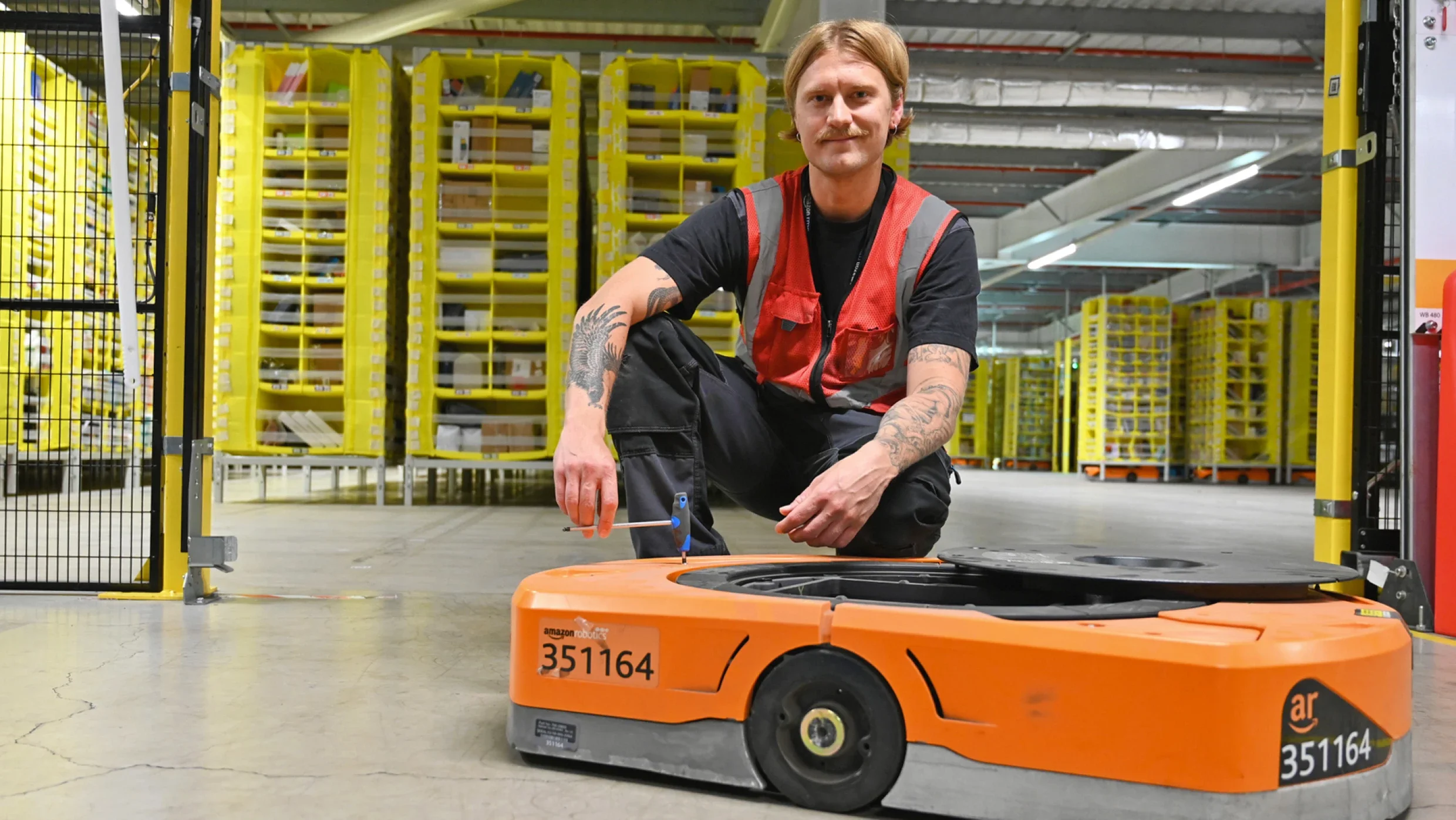Cost Vulnerability in Automation: Designing for Downturns
A reliability maintenance engineering technician at an Amazon fulfilment centre in Bristol, UK.
Credit: Amazon
Turning fixed and bought-in costs into flexible levers
Automation shines when volumes rise and labour markets tighten—but projects are often conceived in boom times and sometimes end up being delivered during slower economic cycles. The underlying cost structure doesn’t help: depreciation, service and SLA contracts, and specialist labour look stubbornly fixed (Type-1), while bought-in inputs such as components, sensors and custom fixtures (Type-2) carry their own exposure to supply shocks. The firms that ride through the cycle are those that redesign both categories so they flex with demand—without sacrificing safety or quality—at the level of each autonomous robot unit. Such a unit is usually a self-contained, safety-bounded production unit built around one or more robots and its peripherals.
Start with what seems fixed. Depreciation is only fixed in accounting terms; operationally it reflects how quickly a unit can be repurposed. Tooling that changes over in minutes rather than hours, parametric “recipes” for motion and vision, and modular fixtures that accept a wider range of SKUs reduce effective fixedness. Specialist labour follows the same logic. Cross-skilling technicians, building SOPs that assume remote support, and maintaining digital twins of units turn expertise from a bottleneck into a managed service. The economic effect is subtle but real: instead of an all-or-nothing utilisation cliff, the unit earns across a wider band of demand scenarios.
Bought-in costs are easier to flex but harder to forecast. Vendors that single-source a critical gripper or camera invite downtime risk that can dwarf any unit saving. Dual-qualifying components, designing mechanical and electrical adapters, and keeping a modest on-site spares pool reduces vulnerability without bloating inventory. Contract manufacturing for sub-assemblies is similar: it spreads load in peaks, but only if documentation and test harnesses are strong enough that quality survives vendor switches.
Buyer psychology and integration
Downturns also change buyer psychology. Operations leaders want to preserve options: defer capex yet keep a path to automation; adopt incrementally without betting the whole line. Offers that combine a small up-front with a floor of service hours and access to upgrade credits answer that need. They de-risk total cost of ownership by bundling predictable maintenance and software updates into a single payment that can be dialled up or down. It sounds like finance, but it’s really confidence: no CFO wants to be trapped in an expensive unit designed for last year’s mix.
Integration plays a stabilising role when communication, support and repurposing is smooth. Reference designs with a library of validated recipes shorten redesign cycles, while telemetry that feeds benchmarks helps customers trust the swap. In the background, procurement teams will justifiably ask for currency and component risk disclosures. Vendors that show their hedging policy, second-source plans and obsolescence strategy will win tie-breakers when projects stall elsewhere.
Two practical playbooks emerge
The first is reconfigurability by default: standard electrical/mechanical interfaces, components that can be quickly changed, and software that promotes parameterisation over hard-coded paths. The second is service as a shock absorber: digital twins, remote diagnostics, predictive parts replacement and outcome-oriented contracts that centre on uptime and throughput at the unit level. Together, these reduce the amplitude of revenue swings while improving cash-flow visibility—valuable for both vendor and customer.
Pricing and packaging should reflect this flexibility. Instead of single, monolithic quotes, present a base unit plus modular options that can be activated or paused with minimal site work. Align payments to realised value—throughput bands, uptime thresholds, or changeover frequency—rather than purely to installed hardware. That turns some Type-1 burden into a variable, predictable service cost and gives both parties room to manoeuvre if the market sours or the SKU mix pivots.
None of this implies cutting corners on safety or compliance. On the contrary, standardised validation artefacts (risk assessments, safety-function verifications, change logs) make it faster to re-approve a reconfigured unit. Decision-makers respond well to vendors who demonstrate that reconfiguration is a documented process, not an improvisation. The credibility you build here is a commercial asset: when budgets tighten, the safer, faster-to-adapt supplier wins the renewal.
Designing for downturns isn’t defensive; it is a growth strategy in slow markets. When rivals freeze, the vendor who makes automation reversible—commercially and technically—becomes the safe choice and exits the cycle with more of the installed base. Build units to evolve, structure contracts to flex, and your automation portfolio will compound even when the macro doesn’t.
